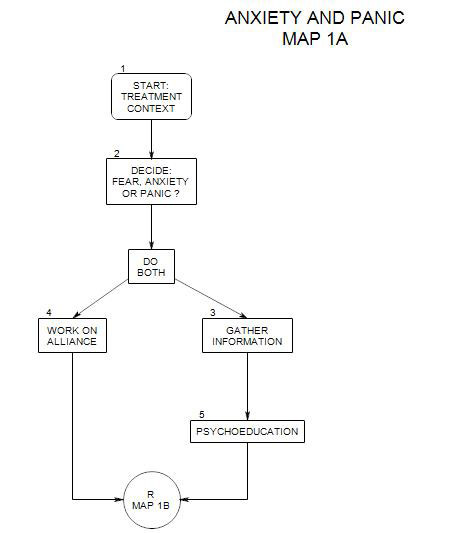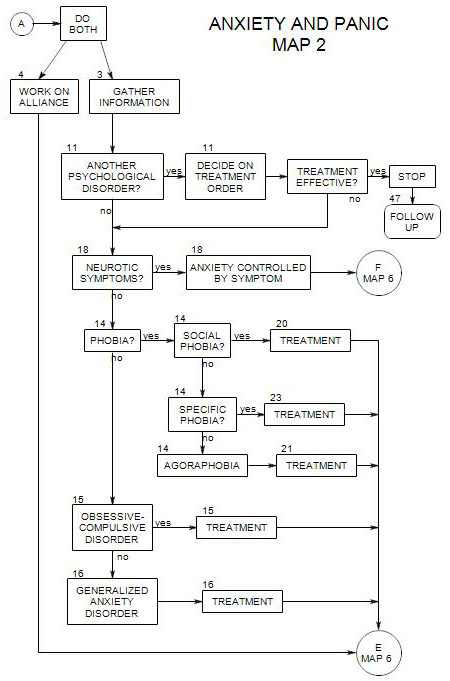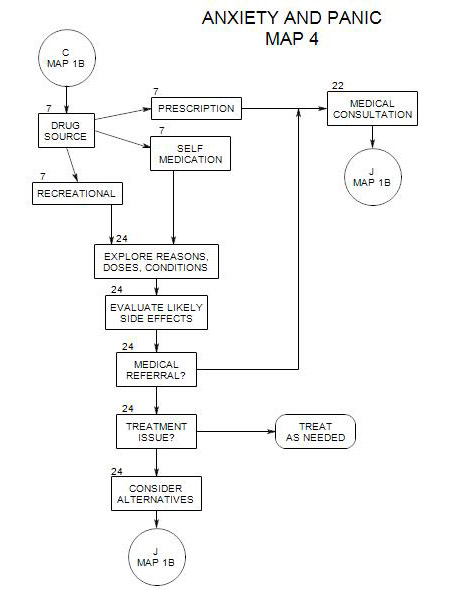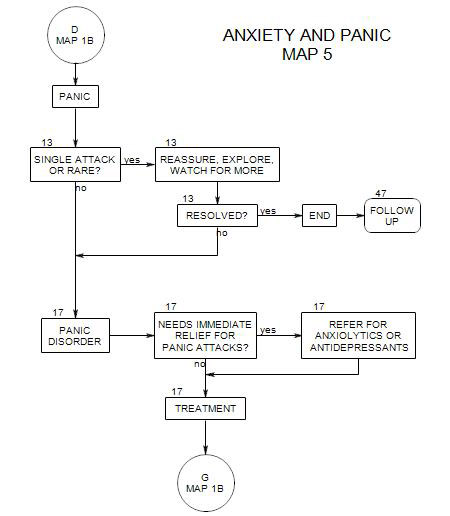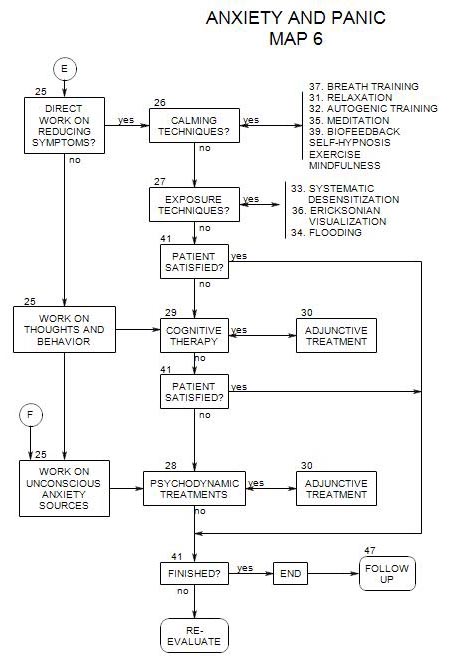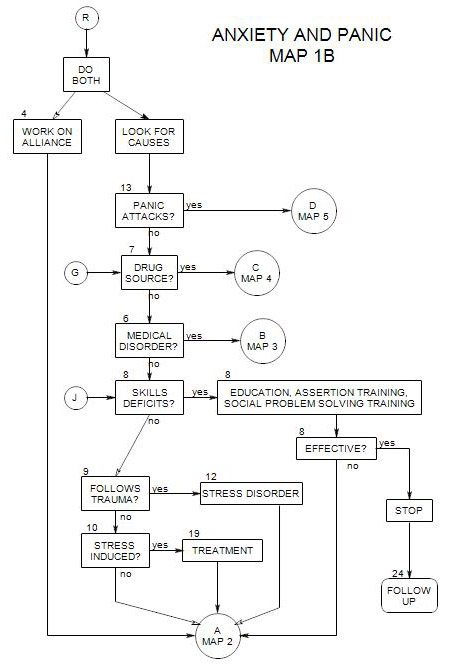
SECTIONS: 4 | 6 | 7 | 8 | 9 | 10 | 12 | 13 | 19 | 24
- Follows Section 1 on Map 1A
2a. Basic Distinctions and Definitions
You may infer that a person is fearful or anxious for any of several reasons:
- He/she tells you that he/she is anxious, tense, worried or apprehensive a lot of the time.
- Someone else says that he/she is anxious or tense.
- The person seems nervous in the session.
- He/she describes experiences or behaviors that could imply underlying anxiety.
While a person’s self-diagnosis is an important piece of information, it may not define the diagnostic and treatment problem. The label may have come from someone else or could be based on the person’s reaction in a specific situation. In that situation, anxiety or fear might be the natural and normal reaction we would expect, and the real issue has to do with the situation, not the patient. It is also possible that the person is anxious or fearful, but that something else in his or her life should be treated first. Some of these questions are raised by the anxiety map.
Fear is commonly a reaction to an immediate danger, a current threat to the person. When a person is afraid, he/she typically can identify a person, object or situation that is the source of his/her fear.
Fear is a sign that you have reached the limits of your comfort zone relative to some situation or task. Fear is awareness of danger. It is an appropriate response to many situations and events in life, and as such should be respected.
Early tasks of diagnosis include trying to determine whether-
- the perceived danger is truly dangerous to the person.
- the danger specified is actually the cause of the person’s fear, or whether he/she is afraid of something else and has misidentified the source.
- the fear is excessive, relative to the actual danger.
- the fear is debilitating.
Anxiety is a focus on a potential threat in the future that one needs to worry about.
Once you suspect that the person is dealing with excessive anxiety or fear, you can watch for or ask about other symptoms that could be caused by it and begin searching for sources.
Anxiety attacks come on quickly and are strong and obvious. They may differ from panic attacks in having clear referents.
Panic attacks are extreme fear reactions, often “out of the blue”, that seem to threaten a person’s very existence. They seem senseless and unpredictable, but very real. There are commonly physiological components, they are time-limited but subjectively endless.
Panic attacks are hard to ignore or rationalize and often propel people into treatment, many times by way of medical referrals. On arrival, the person will typically start by talking about his/her panic attacks.
2b. Symptoms of Fear
Patients are unlikely to come to therapy because of fear. Fear seems real. They are more likely to look for protection or escape than understanding. People aren’t likely to experience fear directly in a session, but they may talk about things that they fear.
If a person is afraid of something – a situation or another person – and you ask, he/she may tell you openly and directly. Or it may remain hidden until the person feels safer with you. And you may not get the details. You probably won’t observe the symptoms.
People may use all manner of ego defenses to avoid experiencing their fears, even when they discuss them – denial, intellectualization, avoidance of crucial aspects of the feared situation or object, etc. You may sometimes be able to infer that a person is afraid of a thought or image if he/she quickly changes the subject, or gets angry, or repeatedly tells you how “fine” things are.
2c. Symptoms of Anxiety
An anxious person experiences fear without being able to connect it to a direct antecedent.
Most of us experience low levels of anxiety from time to time. Rather than being symptomatic of a disorder, they are useful as motivating experiences.
Generally, if a person comes for help because of anxiety, then anxiety is a problem worthy of treatment.
Anxiety is more serious when-
- it leads to physical symptoms.
- the person feels a need to seek medication or to self-medicate for it.
- it leads to overuse of psychological defenses.
- it leads to psychological symptoms.
- it increases to the point of being intolerable.
- it interferes with daily living.
- it prevents us from doing things we need to do.
When people are very anxious, they may report the following symptoms, which may either be fairly pervasive in their lives or tied to specific situations, thoughts, activities, etc.
- nervousness, edginess or tension
- difficulty attending or concentrating
- lightheadedness or dizziness
- shakiness, trembling, restlessness, muscle tension
- rapid heartbeat
- cold hands and feet
- sweating
- shortness of breath, sensation of being smothered
- tingling of the skin
- diarrhea, frequent urination, or both
- feelings of unreality
- difficulty falling asleep
An anxious person is highly motivated to relieve the anxiety and typically has already tried many ways to do so. Some ways may appear to be helpful, such as smoking, drinking alcohol, using prescription or recreational drugs, and so on. In fact, many people believe that they have already dealt with their anxiety and come in for something else.
A patient may be reluctant to give up other symptoms, such as pot smoking, or anxiety medications, or drinking at parties, because the other is a treatment for anxiety. Sometimes, a simple question like “What would happen if you went to the party without having a drink first?” will lead the person to admit to underlying anxiety.
2d. Symptoms of Panic
A panic attack is a period of several minutes during which the person experiences intense fear or discomfort, often without any warning.
It commonly includes both psychological and physiological symptoms.
Psychological symptoms may include-
- general fear.
- discomfort.
- fear of dying.
- fear of going crazy.
- perceptual distortions.
- fear of heart attack.
- feeling unreal.
Physiological symptoms may include-
- sweating
- shaking or trembling
- heart palpitations
- rapid heart rate
- heaviness in chest
- chills or hot flashes
- shortness of breath
- rapid breathing
- dizziness
- light headedness
- headaches
2e. Symptom History
As with any symptom, it is helpful to find out as much as possible about the origin and history of anxiety, fear, and panic symptoms.
You will want to know-
- how long the person has been having these symptoms and when they started. [e.g.: “All my life;” “When I was about 32 years old;” etc.]
- whether any event or time of life can be connected either to the beginnings of the symptoms [“Started the week I was about to graduate from college;” “Started for no reason;” etc.] or to their occurrences [e.g.: “When I have to speak in public;” “Whenever my parents are about to visit;” etc].
- whether certain thoughts or expectations can be connected to them.
- whether they have periodic fluctuations, associated with time of day or the calendar in some way.
- how he/she copes with the symptoms.
- what it means: if the person thinks that there is some message in the symptoms.
- how severe the symptoms are, both usually and in the extreme.
- and any other thoughts the patient has about them.
You will also need to know what the person has done to try to control the anxiety or panic. What happened? Did it work? This can be helpful in both diagnosis and treatment, by helping to eliminate possible sources of the symptoms and in treatment, and by suggesting directions to pursue and to avoid.
As you focus in on specific possible sources of anxiety and panic, it may be helpful to keep the person’s symptom history in mind.
2f. Ongoing Record of Symptoms
It can be helpful to have a patient keep a diary of his/her symptoms. A diary provides a current account, includes greater detail than the person might otherwise remember, and gives a context to symptoms that can help plan treatment strategies.
References: Schneider and Ruhmland, 1997
